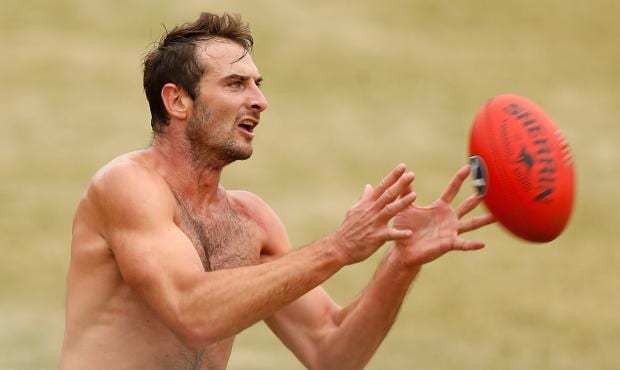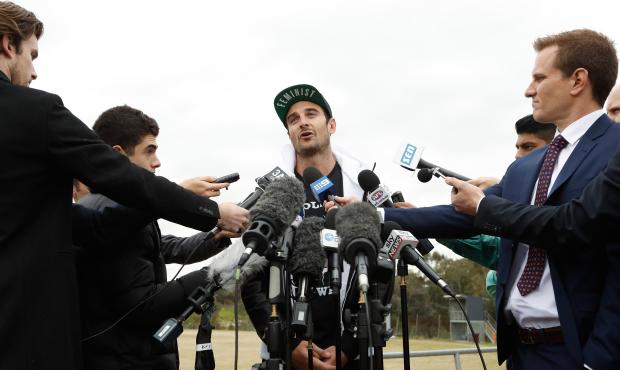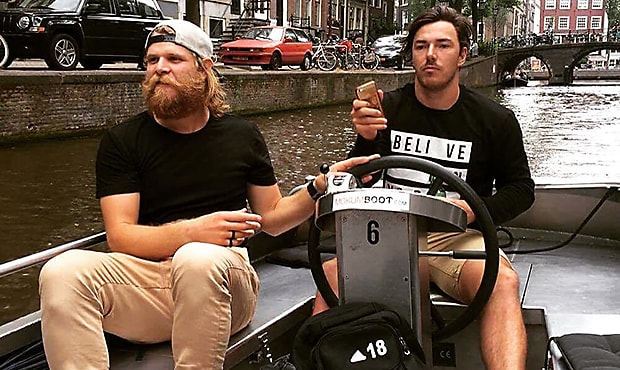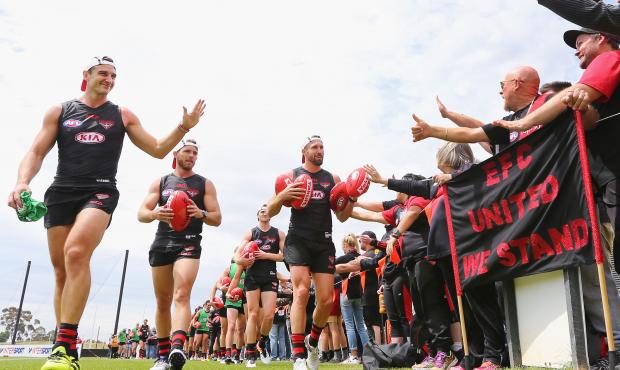Banned from the game they loved, 12 Essendon players were faced with an almost impossible dilemma as they confronted a season without football. They could have followed their initial instincts and walked away from the sport, but instead they drew on each other's inner strength, and dedicated themselves to a tough training regime as they focused on a return to the AFL. With the Bombers closing on a possible stunning return to the finals, Peter Ryan tells their remarkable story of resilience and redemption.
ON JANUARY 12 last year, Essendon CEO Xavier Campbell swept through the club's headquarters at Tullamarine, informing staff that 12 of the club's players had been suspended for a full season for their involvement in the infamous 2012 supplements saga.
Many didn't immediately believe what they'd heard, with their response one of shock.
Holed up at St Kilda's Novotel Hotel in Melbourne's inner south with his now-suspended teammates for company, ruckman Tom Bellchambers' immediate thought was to quit the game.
His skipper, Jobe Watson, a self-described private person, but someone, in his own words, destined to lead the team through mud, was thinking along similar lines.
That day, he later recalled, was the lowest point of his career. Worn down and disillusioned, the joy of footy had turned to dust.
David Myers, an articulate 26-year-old recovering from injury, had sat alongside Watson and Bellchambers 10 months earlier when the AFL Anti-Doping Tribunal had cleared the players of wrongdoing.
He immediately recognised how vulnerable the latest decision made his teammates.
"We knew we had to lean on each other, because no one else knew what we were going through," Myers told AFL.com.au.
Set adrift in a world that had transformed them through relentless headlines from footballers to talkback topics to public pariahs, they had only each other.
Even the most experienced of them, Brent Stanton, found the scrutiny intense and unrelenting.
"You were certainly cautious of what you were doing in public. You always felt like there was that eye on you, judging you for what you had done or because you had been in the paper," Stanton said in We Are Essendon.
Nineteen months after that day, the Bombers remain in the hunt for a finals berth, needing to win their last two matches and rely on other results falling their way for what would be a swift and remarkable return to contention.
Seven of the suspended 12 played in last weekend's loss to Adelaide, with Bellchambers missing due to injury, Tayte Pears having retired, and Stanton and Heath Hocking have been making solid contributions in the VFL team this season. Michael Hibberd has been outstanding in Melbourne's drive to finals, too, having been traded to the Demons at the end of last season.
But the mere fact the bulk of the group has returned, overcoming anger, psychological blows and a loss of faith to play at the elite level again, is primarily because they had each other, their resilience testament to a will and belief in their teammates that has created a unique bond.

The trek back begins
The conditions of the 12-month ban were significant. Players would not be able to take part in any activity under the World Anti-Doping Agency umbrella. Apart from being banished from the AFL, they were unable to play competition golf or have a hit of cricket with mates. Nor could they visit the huddle at a local football match or wander into the rooms afterwards for a beer.
Not only were the players being damned and banned from the AFL, the foundations of their lives were being stripped away.
It was why, following an emotional media conference at which club chairman Lindsay Tanner described the finding as "manifestly unfair", a concerned Campbell organised a phone hook-up that night with the players' families to underline the important role they would play in the recovery process and the support the club would make available.
Those outside the club began to rally, too. Former chairman Paul Little understood what was at stake and set out to create a purpose for those within reach.
By late February, a loose plan began to take shape. David Buttifant, with his infectious personality and decades of experience as the conditioning boss at North Melbourne, Collingwood and Carlton, would lead a fitness program with former Bombers' assistant coach and premiership player Sean Wellman, who at the time was working in mortgage broking.
Buttifant takes a holistic approach to health and wellbeing, and had been Mick Malthouse's trusted lieutenant at Collingwood when it played in five Grand Finals from 2002-11. Wellman is a level-headed man without ego, who had previously coached the banned 12.
Malthouse had helped Buttifant present a plan to several players in mid-February, but they preferred to steer clear of a person with his significant public profile.
A support crew was assembled, too, sporting types without official roles who could help co-ordinate training for players who wanted to participate.
Jobe Watson at training with the banned players at St Bernard's College. Picture: AFL Photos
In that group were Watson's uncle, Dave Holt, a tough Port Melbourne champion who called spades shovels, and his mate Wayne Rodgers, enlisted to run water and lift spirits. Former Carlton physio Simon Nelson was also on board to deal with aches and pains and provide rehabilitation when needed.
All were disconnected, in a professional sense, from the game, which made them eligible to help guide the players.
Adam Iacobucci's gym, a black building surrounded by a wire fence in an industrial area in Airport West, was available for weights sessions, with the relative anonymity it provided a bonus.
Iaccobucci, who played four games for Collingwood in the mid-2000s, was discreet and respected their space, the perfect man to help.
Little had played a part in the logistics and by rallying support, while Allan Dunn, the Bombers' chaplain, was cleared to drop by too if an ear was needed.
What was being established would only become clear later.
"We created a mini-football club," Myers said.
'How had it come to this?'
MANY of the players' minds remained uneasy, however. On February 29, the morning of the first organised training session, reigning best and fairest Cale Hooker parked his black BMW outside Perrett Pavilion at St Bernard's College in Essendon.
Sporting a grey singlet with a faded '89' insignia on the front, shorts and runners, he stared at the vacant football ground in front of him. Try as he might, the big West Australian, who just six months earlier had accepted the 2015 Crichton Medal, could not answer the one question running through his mind: How had it come to this?
He thought, "I'm fit, I'm 27 and I'm as ready to play AFL as I've been in years, and here I am about to start training with seven mates and a bunch of middle-aged men I hardly know at an amateur footy ground, with no chance of playing football for 12 months".
He opened the door and stepped from the car to join Bellchambers, Watson, Hocking, Stanton, Dyson Heppell, Ben Howlett and Stewart Crameri in the amateur club's rooms.
Inside, the mood was quiet, almost awkward, the atmosphere surreal.
St Bernard's vice-principal Tony Paatsch walked down the hill from the school building to tell the group how welcome they were to use the facilities and that, as much as he could ensure, they would be left alone to go about their business.
He didn't tell them of the messages piling in his inbox from former students slamming the school for allowing the banned Bombers to train at the ground.
Paatsch was disheartened but not shocked when emails from old boys questioned why their parents had contributed funds to a school that would open its doors to players suspended by the Court of Arbitration for Sport.
The hard yards: Dyson Heppell leads the way during a session at St Bernard's. Picture: Getty Images
Although the players believed what had happened to them was unjust, former player Brent Prismall, who had joined the Western Bulldogs from Essendon after his AFL career ended in 2012, encapsulated the swirling emotions many experienced post-judgement.
"I find it hard not to be embarrassed about it," Prismall said in a compelling interview on ABC Radio in April, 2016.
On the St Bernard's hill, television cameras were choosing vantage points, preparing to capture images that would later give the haunting impression the players were marooned on a desert island, waiting to be rescued.
Small groups of players kicked footballs to one another in relative silence. Michael Hurley and Myers were absent, both recovering from shoulder injuries, while Travis Colyer would join the crew a short time later.
Some were quick to notice the absence of Michael Hibberd.
"I was supposed to be [there]. I slept in," he said.
Getting on with it
BUTTIFANT had a sense that the muscular players preparing in front of him were hurting, but he also understood that a positive response to their situation would take time.
He also knew he would need to gain their trust, something broken repeatedly since 2012, when the club's discredited supplements program was underway.
"They had no reason to trust me," Buttifant told AFL.com.au.
Buttifant relayed a personal tragedy that was harrowing but real. His teenage son, Nick, had taken his own life seven years earlier. The 53-year-old father, who played two games with Richmond in 1987, explained how he had eventually worked his way through that grief and loss to function in the world again.
He told the players that arriving to train together was a good first step on their own recovery journey, whether they played in the AFL again or not.
Buttifant wrote three training plans on the whiteboard under the headings A, B and C, and asked the players to decide which one they wanted to follow, with long-distance runs and game-based training drills up for discussion.
Much later, Buttifant realised the players always chose the hardest option, the most draining, the tester. These weren't ordinary players. They were All Australians and best and fairest winners or placegetters. Watson had won a Brownlow Medal, an honour that would later be stripped from him.
As time went on, Buttifant and Wellman would notice how high the standard of training was, with Hooker quick to connect speakers to a Bluetooth device in the middle of the rooms to blast music during warm-up. The pair were full of admiration for the players' ability to train with such energy, given what they had gone through.
The rules of engagement were simple. Monday, Wednesday and Friday were training days but there was no compulsion to attend. A simple text when they weren't coming helped with planning drills; sleep, energy levels, mood, muscle soreness and so on were monitored.
The year would be planned by the players for the players.
Said Myers: "[The schedule] bought a sense of normality to what was a pretty abnormal situation. We were able to rock up, go through our work, train, do weights. You did not lose your routine altogether."
An insight into their mindset was clear as they took time to be comfortable with those in their new environment, their lack of trust evident to those around them. Even travel plans were revealed with caution, specific details only emerging over time.
Soon enough, the players stopped discussing their ban at training. They knew lingering on it was pointless.
Watson at the media conference announcing his return to football. Picture: AFL Photos
Pause for thought
ESSENDON started its AFL season on March 26, against Gold Coast.
Buttifant had a message for the group on the Monday after: "One round down, 21 to go."
At training Wellman began to talk with players about the type of football being played and where the game was heading from a tactical viewpoint. Meditation sessions sometimes ended training.
Some weeks went more quickly than others, as the players' emotions dipped and soared. It was a reality they continue to keep hidden from the public eye.
"I don't want to go into too much detail as to what I was dealing with personally," Myers told AFL.com.au in May.
Little, determined that the year wasn't to be wasted, saw an opportunity to invite the players to an experience out of their comfort zones. He arranged for the group to have dinner at the Flower Drum, a top-shelf Chinese restaurant in Melbourne's Chinatown, chuckling as many turned up wearing beanies and thongs.
The mirth stopped soon after the seafood was served, when the occasion became an open forum. Those present say what was evident about the players was the lack of any pecking order as they took the floor. Hocking and Myers spoke about what had happened and what lay ahead. There was no sense of judgement in the room, just recognition that every emotion was acceptable.
The main message from the players to each other was simple: If they had not stuck together, who knows where they would have been, but they certainly doubted they would have been back on track.
"I'm not sure I would have come back to play if we had not been able to train together as a group. I don't think I would have had the motivation or drive to be able to do that by myself," Myers said later.
A sense of normality was returning. Slowly, gradually, the bond was building.
When Stanton brought his toddlers Connor and Aiden along to training while his wife Sonja worked as a paramedic, their innocence provided just the tonic for weary minds.
Cale Hooker celebrates an Anzac Day goal with Brent Stanton. Picture: AFL Photos
The players and their partners sometimes socialised together too, friendships an antidote to the hurt.
The skipper shouted players to a night at Ichi Ni, a Japanese restaurant in St Kilda. They went fishing in Apollo Bay in Victoria's south-west, drank wine at Buttifant's getaway on Phillip Island, south-east of Melbourne, went camping, had a game of golf here and there, and occasionally lived with an abandonment familiar to most young men of similar age.
Hooker invited Bellchambers and Angus Monfries (now at Port Adelaide) to help pick grapes at his family's vineyard in Western Australia.
Such events might seem trivial, but to the people involved they helped strengthen a bond that had proved impossible to break.
"When pressure comes … you can either crack or you can hold together," Watson would say later.
A few players attended AFL games, but it proved anything but relaxing as eyes turned their way. These men weren't dealing with the same scrutiny as most young men.
On April 1, Hocking, a solid individual with a passion for baking bread, became the first suspended Bomber to re-sign and commit to 2017. At times, the 29-year-old had been shattered at the labels others bestowed on him, but he was an Essendon person and he would remain so, alongside his mates.
At training he was a workhorse, driving his teammates through sessions.
On April 26, Essendon announced that Hooker had re-signed, the in-demand key-position player making his decision to stick before any discussion on compensation had started.
Many saw his decision as critical. Hooker's thinking was less complicated, in many ways more genuine.
"The strange thing is we never had a conversation saying, 'Let's all stick together' or anything like that," Hooker said.
"We just wanted everyone to work out what was best for them and we would support each other."
Other players serving their season-long ban as members of other clubs were finding their own way, but were not forgotten.
Jake Melksham had a daughter, Frankie, in the first week of January, her arrival helping him keep perspective (and busy). Jake Carlisle had joined St Kilda and had started working in construction. Paddy Ryder and Monfries were in Adelaide, with each other, but also on their mates' minds.
Hurley and Hibberd trained more often away from St Bernard's than with the others, focusing on building their aerobic fitness rather than their power, but their connection with the others remained strong.
Neither player, however, was ready to commit to 2017.
Those close to the group were relieved to hear many planned European holidays in July.
Hibberd wanted to run with the bulls in Pamplona, Spain, and managed to convince Hurley, Bellchambers and Hooker to join him.
Michael Hurley and Michael Hibberd enjoying Europe. Picture: Instagram @mickhurley
Myers and Heppell planned to travel with their girlfriends in a more sedate manner.
Watson was in New York trying to master making coffee with almond milk as a barista at the Hole in the Wall Coffee Shop on Fifth Avenue in Manhattan. He received training programs via email and did pilates sessions as he hedged his bets, his football future far from certain.
"I leant either way for a long time. When I left New York, I didn't think I'd be coming back to play AFL," Watson said.
While away he realised "how liberating it is to speak openly and honestly with someone, and how good it is for your mental health".
With only those involved really knowing what had happened at the club in 2012, a group gathered together in Croatia for a few days to let their hair down and relax.
Some might have been envious, but good times were only part of accepting what had happened, conversation occasionally becoming emotional if the mood took hold.
"We wouldn't have got through it if you were dwelling on how shit everything was. So just like anything, you look for the best in it, get on with it and try to focus on that," Myers said.
"It wouldn't matter what job you were doing. That is how you have to deal with it."
Those close to the players sensed a new focus when they returned, a break from familiar surrounds had enabled them to see the wood for the trees. That clarity enabled many to regroup and make a clear decision on their future.
"We learned a lot about ourselves during that period," Hooker said. "We learned a lot about each other as well."
The bond Watson recently described as "unique" had strengthened.
Fans welcome back the banned players on their return in November last year. Picture: AFL Photos
Gaining perspective
BEN HOWLETT opened up during a trek up Mt Donna Buang in Victoria's Great Dividing Range in August about how much inspiration he derived from his brother Ty's efforts to recover from a car accident in 2009. The accident had cost Ty his right arm, and had almost killed him, but he had returned to football within months and continually lifted Ben's spirits throughout four years.
Such perspective began to flourish as physical activity, a new environment and connection with mates helped to build resilience as November, when the players could return to the AFL, came into view.
"They were obviously difficult times. The fact you have nine or 10 blokes in the same boat made it a little bit easier," Bellchambers said.
Big decisions remained.
Hibberd had an offer from Melbourne to consider upon his return. He had seriously enjoyed his break, his teammates teasing him about the size of his bum as he grabbed an extra vanilla slice at training one day.
After leaning towards returning to Essendon while in Europe, once home he decided to join the Demons, the prospect of a fresh start exciting him. He knew how important his friendships with the other banned players were, so he phoned them one by one to deliver the news.
Hurley announced in August he was staying with the Bombers, after much speculation and consideration of other opportunities. Then, on September 22, Watson posted an Instagram picture of his bulldog Benson with a pair of footy boots. His accompanying words brought a smile to many: 'Hey Mate, I'm going to need to borrow these back off you'.
"What it really came down to was finishing on my own terms," Watson said.
He also wanted to play alongside his teammates again, given how far they had fallen away from ever playing again.
Heppell told reporters about his relief at being back inside the place he had been forced to leave nearly a year earlier, "It's certainly a step towards closure, and a very big step at that."
Hooker's outlook had changed, too. He had moved on from that first day of training in February. He knew success in such a brutal game demanded he remained dedicated, but he had found perspective.
"Sometimes you can be so centred on footy that you forget how important everything else is. In the scheme of everything, footy is not as important as you sometimes feel it is," he said.
Returning players celebrate the win over Hawthorn in round one. Picture: AFL Photos
Myers could even admit his 2016 was enjoyable, notwithstanding the circumstances. There was a silver lining: he now understood better what lay beyond football.
"The No.1 priority is to make sure I can commit myself and give everything I have to whatever time I have left," he said.
"But at the same time, having had last year I am not apprehensive to what footy looks like either.
"I'm quite looking forward to what life will be once footy is over."
That's the bright side the players focus on now, knowing the darkest clouds have passed.
Most are still reluctant to share the experience in detail, with Hurley telling The Footy Show why in August: "The more I speak about it the sadder it becomes".
In football terms, so much had been lost: a finals series, a Brownlow Medal, the ability to enjoy the game, a coach, valuable years of a career.
Importantly, so much more had been placed at serious risk: friendships, trust, personal wellbeing, and a person's place in the world had been put in jeopardy.
The impact the ordeal had had on their coach James Hird was underlined in January when he was admitted to hospital after a major health scare.
His health now appearing on track, he recently accepted an AFL invitation to present the Norm Smith Medal on Grand Final day this season.
Although resilience, mateship, plenty of laughs and support had helped the Bombers' contingent through to the other side – just – some scars remain.
They've certainly changed, but they have also grown.
"It's a little bit like [being] in a relationship [and] your partner cheats on you…you might get back together [but] you probably don't love her the same way," Watson said when he announced his impending retirement last week.
No one argued with that, but it didn't mean the game no longer provided moments to savour, as Bellchambers revealed after round 16 when he recalled palming the ball down to his mate, Watson, in the middle of the MCG an hour earlier.
"After everything Jobe has been through and we've been through as a group, to get back out on the MCG and smile and hit the ball to him does feel nice," Bellchambers said.
That mini-football club, consisting of a bunch of heartbroken mates and a few open-hearted trainers, had proved bigger than the individual.
And the lessons learned might serve everyone well when pressure comes, particularly if they heed Tim Watson's message to his retiring son.
"It's a big world out there, go and experience it."


